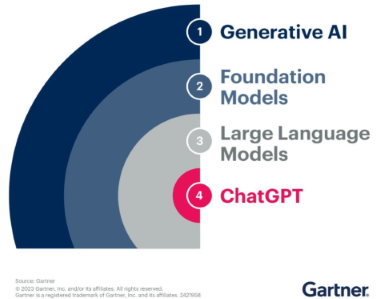Generative AI & Contact Centres: A Practical Guide
Whilst there has been more than a decade of talk about AI in contact centres, with what many would say have been underwhelming practical applications, the introduction of recent advanced large language models (LLMs… think ChatGPT) is going to change the game.
Matt Sanders
Whilst there has been more than a decade of talk about AI in contact centres, with what many would say have been underwhelming practical applications, the introduction of recent advanced large language models (LLMs… think ChatGPT) is going to change the game.
And whilst this is really exciting, it means if you’re running a contact centre, you need to make near term strategic technology choices (and ideally the right ones!) to be able to execute GenAI business strategies in the years ahead.
Overview
The highly publicised entrance of ChatGPT (which is powered by a leading LLM from OpenAI) and the maturity of machine learning services has led to the birth of Generative AI (aka “GenAI”). LLMs produce human-like word based outputs based on highly tuned patterns and training data, which through the integration into high quality private data sources (think internal knowledge basis and agent training material), creates the ability to provide human-like answers to business-specific customer questions. Through extensions of this capability into external systems (like CRMs and payment gateways), businesses can enable basic business functions to be performed without a human (think change your address, identify an error and process a refund).

Further, there are a range of analytics and insights activities which LLMs are starting to be used for, such as interaction summaries and classifications. These analytics use cases are going to expand rapidly and will likely change the way we look for trends and ensure compliance and quality in the contact centre sector in the years ahead.
This all has the obvious potential to revolutionise customer experiences, streamline workflows, and rapidly reduce the need for human effort across contact centre operations. However, whilst there is a lot of hype around GenAI at the moment, we think it’s important to assess the likely practical applications, limitations and strategic considerations for GenAI in contact centres. In this article, we will share our latest insights from our technology teams and various discussions we are having with other technology leaders in the contact centre and broader CX sector.
I. Understanding Generative AI in Contact Centres
In practical terms, the most common application of GenAI in contact centres is through the deployment of next gen, conversational chat and voice bots. These AI-powered virtual agents are designed to engage with customers in a manner that closely resembles human conversation. They can understand natural language, interpret customer queries, and generate responses that are contextually relevant and personalised. With extensions into private data sources and business applications (think knowledge bases and CRMs), these bots can also give highly contextualised responses as well as perform basic tasks that are currently performed by humans (think giving personalised guidance on fixing a customer issue, changing addresses or even identifying and effort and processing a refund).
With a robust feedback loop, coupled with proper error handling and response strategy management, these bots can “learn” from customer interactions and continuously improve their understanding and conversational abilities over time. This means that they can become more intelligent and helpful the more they operate, similar to a human agent - except these virtual agents don’t ever leave (or sleep)!
But it is important to recognise the additional, and potentially as powerful, applications of GenAI in the back office of a contact centre environment. This is going to include the automation operation and support activities, such as quality assurance and compliance reviews, but also in the classification and summarisation of interactions, enabling the next generation of insights to be delivered from companies' customer conversations.
II. Pros of Applying Generative AI in Contact Centres
Here are a list of the key practical benefits we believe will be delivered through the intelligent application of GenAI in contact centres.
- Efficiency and Scalability: intelligent application of GenAI solutions can enable the reduction in human bottlenecks, enabling a higher volume of customer interactions, as well as providing immediate customers responses and freeing up human agents to focus on more complex queries.
- Enhanced Routing: through enabling automated, conversational contact reason identification, without the need for complex IVRs, companies can create engaging, efficient and accurate way to send interactions to the right queues/teams.
- Enhanced Customer Experience: by leveraging GenAI, contact centres can offer personalised and contextually relevant responses, improving customer satisfaction and increasing the likelihood of a customer actually leveraging AI.
- Reduced Response Times: GenAI will enables contact centres to provide limitless and round-the-clock support, ensuring customers can seek assistance at any time and without long wait times, leading to improved service availability.
- Increased Agent Productivity: GenAI can assist human agents by providing relevant knowledge, suggested responses, and automating repetitive tasks, thereby improving agent efficiency.
- Reduced Back Office Effort: through automating activities like quality assurance and compliance checks and post call work (e.g. call classification and summaries), companies will be able to reduce the level of human labour required to deliver the same (or superior) outcomes.
- Data-driven Insights: GenAI facilitates highly customisable and in depth analysis of complex customer interactions, which will allow contact centres to extract valuable insights, identify trends, and make data-driven decisions for process optimisation and service enhancements.
III. Limitations and Challenges of GenAI in Contact Centres
There are real limitations and potential serious risks from using GenAI in contact centres that need in depth consideration.
- Lack of Human Touch: while GenAI can emulate human-like responses, it lacks the empathy and emotional connection that human agents can provide, particularly in sensitive or complex situations.
- Handling Complex Queries: GenAI-powered systems may struggle with intricate queries that require nuanced understanding, creative problem-solving, or extensive domain knowledge, leading to potential frustrations for customers.
- Incorrect or Misleading Output: LLMs can create factually incorrect output when it doesn’t have a direct answer available - these responses can be completely made up at worse, or even just misleading at best, so without the right controls and close monitoring, they can lead to to poor or even damaging outcomes.
- Language and Cultural Limitations: GenAI models may encounter challenges in understanding dialects, accents, idiomatic expressions, or cultural nuances, posing difficulties in delivering accurate and appropriate responses for diverse customer bases.
- Knowledge Maintenance & Updates: GenAI solutions in contact centres are going to rely on up to date knowledge for any application to add value - this means this knowledge is going to have to be maintained and updated as the business and customer needs change (e.g. new products services, new problems etc). Neglecting this will result in significantly less effective business and customer outcomes.
- Integration Complexity: incorporating GenAI into existing contact centre ecosystems may require significant resources, expertise, and compatibility considerations, potentially posing implementation challenges (i.e. integrations into changing systems like CRMs and transactional systems).
- Overall ROI: the complexity and costs outlined above, along with general software and processing cost of using advanced generative AI models can currently add up to be quite expensive (shameless self plug: without the right partner to guide you), so without clear and direct cost savings, it might not stack up in a business case.
IV. Key Strategic Considerations
One of the more complex architectural design decisions will be how you integrate with your contact centre technology. It can be overwhelming to understand all the technology options and decisions required but we’ve tried to simplify into 4 key steps.
- Define your objectives - ensure engagement with relevant stakeholders to ensure you have alignment on what the short and long term goals are from your GenAI strategy - best practice sees quick wins but with a system architecture that enables efficient and effective progression towards your longer term goals.
- Understand your contact centre technology AI offering - look to see if your contact centre tech has pre-built options or if they offer a more open architecture, which allows you to plug in to third party providers. If it’s a closed shop, then you are going to be limited to what your contact centre software offers (spoiler alert : this is not a good thing).
- Design your architecture and integration strategy - working either with internal experts or external partners (shameless self plug # 2: like Contacx), with solid understanding broader objectives whittled down to your functional and non-functional requirements, work through the variety of architectural decisions such as your data/ML ecosystem (e.g. Microsoft, AWS etc) and your LLM of choice (e.g. OpenAI, Google, Meta, Hugging Face). Pro tip: this is where a deep technical understanding of the technology landscape and alignment to your functional/non functional requirements can be incredible valuable.
- Design your operational model - build out the model to ensure you have the appropriate processes in place for a robust feedback loop, error handling and response strategies as well as data security and system scalability considerations.
Conclusion
Generative AI is going to revolutionise contact centres, offering benefits such as enhanced efficiency, improved customer experiences, and data-driven insights. However, it is important to understand that there are a number of critical technology and business decisions, along with operational process adjustments, that are needed to ensure you can deliver quality outcomes that scale. Getting this strategic architecture and strategy designed right from the start will help ensure your business can deliver value whilst avoiding the various pitfalls that exist. It is also critical to maintain a customer-centric approach while upholding ethical and responsible practices. So this clearly isn’t going to be an easy process to navigate for contact centre leaders, but if you can get it mostly right, you will see huge upside from the GenAI revolution.
Latest Stories
Here’s what we've been up to recently.

4 Practical Applications of Amazon Connect Contact Lens
Amazon Connect Contact Lens is a powerful tool designed to provide deeper insights into contact centre operations, improve agent performance, and deliver enhanced customer experiences. This article explores the key features of Amazon Connect Contact Lens and its practical applications, including creating reporting categories, real-time alerts for high-risk customers, theme
Matt Sanders

